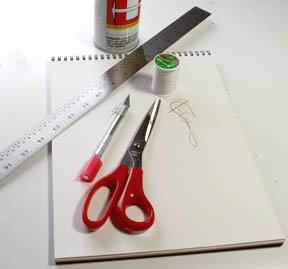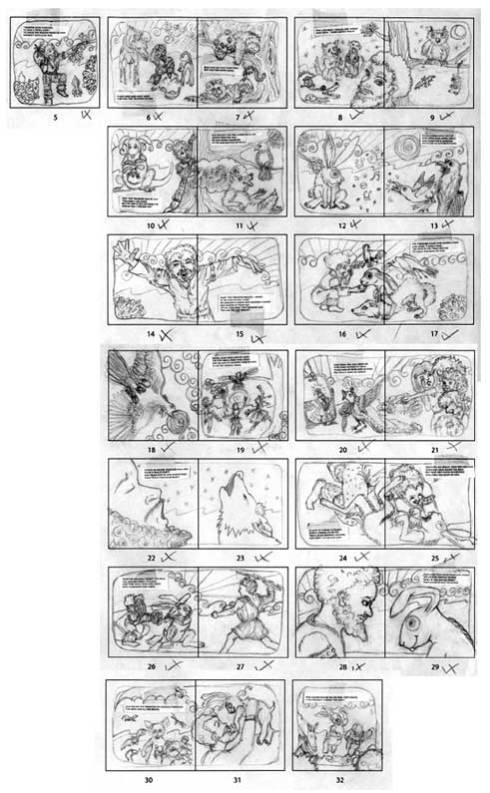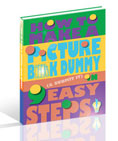
Collage by Vicky Lorencen
Back in the late 1900s, there was a clever public service announcement encouraging seatbelt use. It featured crash test dummies and the tagline “You can learn a lot from a dummy.”
Fast forward to, well, right this very minute. When I hear the word dummy, I think of a mini mock-up of a picture book, not a badass mannequin.
Some of my friends write picture books exclusively. (If you must know, I admire/loathe them all. Blast their bundles of talent! Promise not to repeat that, okay?) While, I, on the other cramped hand, write picture books illusively. Meaning, I get a won’t-go-away idea. I do my best to puzzle the idea into a manuscript and then tinker with it until it begs for mercy. Then rinse and repeat. It is never easy or pretty. But, Seuss help me, it brings me a perverse, inexplicable delight when I finally pin that butterfly of an idea to the board. Making a dummy helps me get to that point.
Whether you and picture books are going steady or you only hang out when the mood strikes, dummy-making may be wise for you too.
Smart dummy pointers . . .
- Do not waste a nanosecond worrying about your inability to draw. Dummies are designed to be tools, not objets d’art.
- Illustrators need a dummy. Writers need a dummy. All God’s children need a dummy (more or less).
- If your picture book word count needs a serious count down, making a dummy can really help. You can easily see which words are keepers and which are just leftovers. Aim for 500 or less–a whole heap less.
- Dummies will also tell you if your cute or clever idea is robust and active enough to sustain a 32-page page-turner.
- For a tip-top primer on how to make a dummy, visit this blog post from picture book author extraordinaire Tara Lazar.
- At a recent SCBWI event, I picked up this cool trick from masterful picture book author Kelly DiPucchio. Once Kelly has a decent draft, she prints it and cuts out each line, then uses an existing 32-page picture book (any one will do) to check her pacing. She paperclips or lightly tapes her lines into the book to see how well her story fits the format. If not, she can tailor and tighten or expand.
You simply must be convinced of a dummy’s brilliance by now.
And so, my little cummerbund of cuteness, my bon vivant of brilliance, do you dare devise a dummy? Indeed, I hope you do.
Creativity is just connecting things. When you ask creative people how they did something, they feel a little guilty because they didn’t really do it, they just saw something. It seemed obvious to them after a while. That’s because they were able to connect experiences they’ve had and synthesize new things. ~ Steve Jobs


 When I was a child, I had a reoccurring nightmare. I was on a field trip with my third grade class in a large grassy area with a huge tree in the middle. All the kids were following the teacher across the field and under the shade of the tree. I wasn’t a very popular child, and I was in the tail end of the line.
When I was a child, I had a reoccurring nightmare. I was on a field trip with my third grade class in a large grassy area with a huge tree in the middle. All the kids were following the teacher across the field and under the shade of the tree. I wasn’t a very popular child, and I was in the tail end of the line.
As I passed under the shadow of the tree, I noticed a large hole in its roots. At that moment a fierce bunny sprang out of the hole and grabbed me, pulling me down into the hole with it. I tried to call out but to my dismay my voice had gone silent.
Needless to say I woke up in tears and a cold sweat.
I still have dreams where I’ve lost my voice. Words fail me.
What a terrible place for a storyteller to find herself.
I’ve never considered myself a writer or a wordsmith. I do love words though. Their history, the way they sound, how when strung together in an organized fashion they can open up the universe to those who read them. So when I approach a picture book, I see pictures first. I write down what I see. Then comes the hard part of making the words sing. Because that’s what words in a picture book need to do.
 You’ve stuck it through November and have a list of 30 ideas. If you have lists like mine, most of the ideas are stinkers. I’ve been doing PiBoIdMo for more than a few years now, and I do see recurrent themes on my lists. Maybe you also have repetitive ideas on your list. No matter. We’re storytellers. Take those ideas and get visual!
You’ve stuck it through November and have a list of 30 ideas. If you have lists like mine, most of the ideas are stinkers. I’ve been doing PiBoIdMo for more than a few years now, and I do see recurrent themes on my lists. Maybe you also have repetitive ideas on your list. No matter. We’re storytellers. Take those ideas and get visual!
As an artist, I work on picture and text together, creating a dummy. Even if you aren’t a professional illustrator, you can use the framework of the dummy to really make your story shine. And your words sing.
For several years at #kidlitart, with my co-host Bonnie Adamson, we held the Picture Book Dummy Challenge. A lot of the people participating came directly from Tara’s PiBoIdMo. (#Kidlitart chat is on hiatus until Bonnie and I have more time to devote to it again. We’re both busy making lots of dummies!)
A picture book is a partnership of words and images. As word counts drop, the illustrations have to carry more of the story, and things like page turn in the text have to be concise.
This is where a dummy becomes a most excellent tool.
A dummy will tell you if:
- Your story is strong enough to carry through a 32-page book.
Since word counts have been dropping over the last decade to close to 500 and sometimes even less, it is hard to tell if you have a book on your hands (as opposed to a magazine story.) When a manuscript is laid out in a dummy you have visual clues to show you where your story needs more action, drama or dialogue.
- There are enough action scenes for 15-20 images.
An illustrator’s job is to take your manuscript and enhance the story you have written. If you only have a few scenes, this will be downright challenging. Think about your favorite picture books. Does the character move through time and space from the beginning of the book to the end? Or does the character stay in the same place for the length of the story? When a manuscript is laid out in a dummy you have visual clues to show you scene changes. There need to be scene changes.
- The page turns (or the breaks between action) are interesting enough to keep the reader moving to the next page.
In novels there are chapters. Usually the end of the chapter is written in such a way that you want to keep reading. There could be a cliffhanger or some sense of tension in that chapter end. Whatever it is, you feel compelled to get to the next chapter and find out what happens. You care what happens. You can’t wait to find out what happens. When a manuscript is laid in a dummy you get visual clues on your “chapter endings” to show if your page turns will propel the story forward.
- There is too much visual description in your text.
Five hundred words is not a lot to tell a story with a beginning, middle and end; to include a story arc and achieve character growth. The last thing you want to do is talk about red hair and green eyes, or blue sky and orange sunlight. Leave that to the illustrator. Save your words for things that can’t be seen. When a manuscript is laid out in dummy you get visual clues on your descriptions. Are you using precious word count to describe something seen?
All my books start as tiny scribbles. Even if you’re not an artist, you can scribble your ideas down, can’t you?
Here is the thumbnail layout for one of my books, RABBIT’S SONG by S.J. Tucker.

Once you have your scribbles down, you can make a little booklet. It never ceases to amaze me what a difference having a physical dummy makes in visualizing where your manuscript needs some attention.
 I’ll be giving a way a copy of my e-book “How to Make a Picture Book Dummy in 9 Easy Steps” to one lucky commenter. So let me know how you plan to take your 30 ideas and make them into amazing stories! A winner will be selected in one week. Good luck!
I’ll be giving a way a copy of my e-book “How to Make a Picture Book Dummy in 9 Easy Steps” to one lucky commenter. So let me know how you plan to take your 30 ideas and make them into amazing stories! A winner will be selected in one week. Good luck!
.
A transplanted New Yorker now living in Missouri, Wendy Martin has been working as an illustrator for 25+ years. She earned a degree in Fashion Design from the Fashion Institute of Technology, then continued her art education at the School of Visual Arts with a B.F.A. in Graphic Design. After her move to Missouri in 2000, she turned her focus to her true love, children’s books. AN ORDINARY GIRL, A MAGICAL CHILD, a children’s book she both wrote and illustrated, was released in 2005. The book was picked up by a new house, edited and re-released in 2008, then went on to become a finalist in the 2009 international COVR awards. Four additional picture books and a coloring book quickly followed. Visit her on the web at WendyMartinIllustration.com.



Making children’s book dummies can be a frustrating process-pages buckled, type cut off, spines not lining up—to a point where you don’t want to make dummies at all. But as an illustrator of children’s books, you know that making dummies is an essential part of the process. Here’s a step-by-step guide for making a 32-page picture-book dummy with, hopefully, less fuss:
WHAT YOU’LL NEED
Manuscript
2 small binder clips
Sketches
Pencil
Glue stick
Metal ruler
X-acto knife
Cutting mat*
* Paper trimmers work too, but the knife/mat method gives you more control.
BEFORE STARTING
Decide what size your book will be. Some illustrators choose to make dummies at one hundred percent, others create smaller dummies. Making dummies at a smaller size reduces photocopying costs. At fifty or sixty percent, you can usually fit a full spread on a sheet of 11” by 8.5” piece of paper.
Set your manuscript in a basic typeface such as Times or Helvetica and at a smaller size suited to the size of the dummy. The width of the text on any single line cannot exceed the width of a single dummy page, so make sure you give the text some room.
Illustrators usually include one or two finished color samples with the submission package. Some paste the color spreads directly into the dummy, and some include separate printouts. It’s your choice.
ASSEMBLY
1. Photocopy your manuscript and each spread of your sketches. Don’t forget to include title page, copyright/dedication page and end papers. End papers are used to adhere the pages of a book to its cover. Not all illustrators use or show end papers, but they can be a way to tell more of your story visually.

2 & 2b. Cut each spread to dummy size.

3. Fold each spread in half.

TIP: Make an extra copy of everthing in case of mistakes.
4. Mark the back of each spread with page numbers to keep track. Most picture books follow this sequence:
1 Title Page
2&3 Copyright/Dedication/half title
4&5 Opening spread for story
6&7 Second spread
And so on …
32 Last page of story

TIP: Odd-numbered pages appear on the right and even-numbered pages on the left of a book. If you use end papers, don’t include them in the page count, even though they’ll appear at the front and back of the dummy.
5. Cut the manuscript into blocks of text. Lay out the spreads and decide where each block of text will go. Try to evenly distribute the words unless the context of the story calls for something different.

6. Glue your text to the pages.
![]() 1 Comments on Crafting A Book Dummy, last added: 5/16/2012
1 Comments on Crafting A Book Dummy, last added: 5/16/2012




 When I was a child, I had a reoccurring nightmare. I was on a field trip with my third grade class in a large grassy area with a huge tree in the middle. All the kids were following the teacher across the field and under the shade of the tree. I wasn’t a very popular child, and I was in the tail end of the line.
When I was a child, I had a reoccurring nightmare. I was on a field trip with my third grade class in a large grassy area with a huge tree in the middle. All the kids were following the teacher across the field and under the shade of the tree. I wasn’t a very popular child, and I was in the tail end of the line. You’ve stuck it through November and have a list of 30 ideas. If you have lists like mine, most of the ideas are stinkers. I’ve been doing PiBoIdMo for more than a few years now, and I do see recurrent themes on my lists. Maybe you also have repetitive ideas on your list. No matter. We’re storytellers. Take those ideas and get visual!
You’ve stuck it through November and have a list of 30 ideas. If you have lists like mine, most of the ideas are stinkers. I’ve been doing PiBoIdMo for more than a few years now, and I do see recurrent themes on my lists. Maybe you also have repetitive ideas on your list. No matter. We’re storytellers. Take those ideas and get visual!








Taking the time to make a dummy is soooo important! Thanks for showing us yours!
Hi Wendy. I’ll probably color in my rough sketches. Maybe the magic marker will make up for my silly scribbly characters.
Hi, Wendy! I’m a very visual person, so creating dummies for my manuscripts is a vital step for me. I hope to do that with at least ten of my 30 ideas from November!
This is fantastic. I love when you said, “Five hundred words is not a lot to tell a story with a beginning, middle and end; to include a story arc and achieve character growth . . .” This is wonderful to know as a reviewer. I always knew it but to point to a blog posts to support my remark of not having those things though purporting to have them.
As a writer, I LOVE this post. I was always told not to worry about the Dummie, that was for the illustrator. Well, I think using one will help me and I thank you for bringing that home to my sometime mushy brain. I WANT your Dummie Book. Please, pull out my name. I know begging does not help, but it cannot hurt. Luck shine on me tonight (or whenever this is pulled),
Off the back of the 12×12 in 2012 challenge, I launched #FirstDraftFriday for myself in order to play catch up and it’s worked a treat. Once I’ve got enough first drafts sorted, I’ll re-purpose my Friday time slot for something else.
In the meantime, looks like I may need to start on #MakeADummyMonday
To answer your question, I plan to weed out what will not work and then use your dummie lesson here to use a dummie and find the best fit. I love animals and will most likely use one of those themed ideas I have had. I would mention an idea or two but you know the code . . . if I told you I’d have to break your fingers and ruin your Dragon Speak.
Thanks for this post. I love your idea of a writer’s “scribbles” as a first step.
Anjali
Dummies are a lot of fun as well.
I am starting with the ideas that excite me the most. Then I will play with them till I get them out of my system or they have metamorphisized into a PB possibility…then play with them some more, and this time I will include making a dummy! And then shine and polish into a full PB manuscript. Happy play times ahead! Thanks for your post.
Great blog. I have only just tried using page spreads and dummies and YES!, my story is deffinately tighter and enables me to cut out text where they could be illustrations. Thanks.